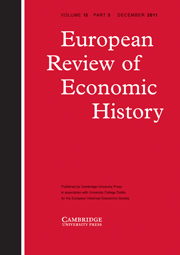Crossref Citations
This article has been cited by the following publications. This list is generated based on data provided by
Crossref.
Eichengreen, Barry
and
Flandreau, Marc
2010.
The Federal Reserve, the Bank of England and the Rise of the Dollar as an International Currency, 1914-39.
SSRN Electronic Journal,
EICHENGREEN, BARRY
2011.
IT MAY BE OUR CURRENCY, BUT IT'S YOUR PROBLEM.
Australian Economic History Review,
Vol. 51,
Issue. 3,
p.
245.
FAITH, ROSAMOND
SCHOFIELD, P. R.
HEALEY, JONATHAN
MURPHY, ANNE L.
BRADLEY, KATE
TAYLOR, JAMES
and
BROWNLOW, GRAHAM
2011.
Review of periodical literature published in 2009.
The Economic History Review,
Vol. 64,
Issue. 1,
p.
256.
Eichengreen, Barry
2011.
The renminbi as an international currency.
Journal of Policy Modeling,
Vol. 33,
Issue. 5,
p.
723.
Fields, David
and
Vernengo, Matias
2011.
Hegemonic Currencies During the Crisis: The Dollar Versus the Euro in a Cartalist Perspective.
SSRN Electronic Journal,
Cohen, Benjamin J.
2012.
The Benefits and Costs of an International Currency: Getting the Calculus Right.
Open Economies Review,
Vol. 23,
Issue. 1,
p.
13.
Maes, Ivo
2012.
On the Origins of the Triffin Dilemma: Empirical Business Cycle Analysis and Imperfect Competition Theory.
SSRN Electronic Journal,
Urban, Scott
and
Straumann, Tobias
2012.
Still tied by golden fetters: the global response to the US recession of 1937–1938.
Financial History Review,
Vol. 19,
Issue. 1,
p.
21.
Eichengreen, Barry
and
Flandreau, Marc
2012.
The Federal Reserve, the Bank of England, and the Rise of the Dollar as an International Currency, 1914–1939.
Open Economies Review,
Vol. 23,
Issue. 1,
p.
57.
Ugolini, Stefano
2012.
The Gold Standard Peripheries.
p.
107.
Oatley, Thomas
Winecoff, W. Kindred
Pennock, Andrew
and
Danzman, Sarah Bauerle
2013.
The Political Economy of Global Finance: A Network Model.
Perspectives on Politics,
Vol. 11,
Issue. 1,
p.
133.
Eichengreen, Barry
2013.
ADB Distinguished Lecture Renminbi Internationalization: Tempest in a Teapot?.
Asian Development Review,
Vol. 30,
Issue. 1,
p.
148.
Eichengreen, Barry
2013.
ADB Distinguished Lecture Renminbi Internationalization: Tempest in a Teapot?.
SSRN Electronic Journal,
Drezner, Daniel W.
2013.
Military Primacy Doesn't Pay (Nearly As Much As You Think).
International Security,
Vol. 38,
Issue. 1,
p.
52.
Fields, David
and
Vernengo, Matías
2013.
Hegemonic currencies during the crisis: The dollar versus the euro in a Cartalist perspective.
Review of International Political Economy,
Vol. 20,
Issue. 4,
p.
740.
Maes, Ivo
2013.
On the origins of the Triffin dilemma.
The European Journal of the History of Economic Thought,
Vol. 20,
Issue. 6,
p.
1122.
Maass, Richard W.
Norrlof, Carla
and
Drezner, Daniel W.
2014.
Correspondence: The Profitability of Primacy.
International Security,
Vol. 38,
Issue. 4,
p.
188.
Kirshner, Jonathan
2014.
Same as it ever was? Continuity and change in the international monetary system.
Review of International Political Economy,
Vol. 21,
Issue. 5,
p.
1007.
Norrlof, Carla
2014.
Dollar hegemony: A power analysis.
Review of International Political Economy,
Vol. 21,
Issue. 5,
p.
1042.
Prasad, Eswar S.
2014.
Global Implications of the Renminbi's Ascendance.
SSRN Electronic Journal,


